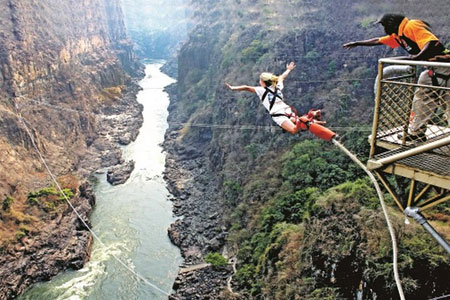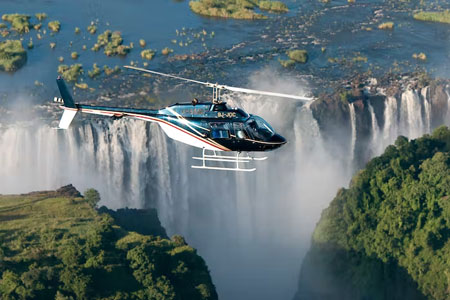Rehoboth Tours & Safaris
Rehoboth Tours and Safaris is a Zimbabwe-registered company with offices in the tourist capital of Victoria Falls, Zimbabwe. The Company specializes in providing services such as Mid-budget to Luxury Safari lodges, Budget Camping, Hwange Safari trips, Chobe full-day trips, Hotel Reservations, packaged Tours and Excursions, Activities, and Airport transfers in Zimbabwe, Botswana, Zambia, South Africa, and Namibia.
TOP
ZAMBIA
ATTRACTIONS
EVERYDAY IS A HOLIDAY.
Official name: Republic of Zambia
Capital city: Lusaka
Population: 17,426,623
Area: 752,618 sq km
Major languages: English, Bemba, Nyanja, Tonga
Time zone: UTC+2 (Central Africa Time)
Zambia is a landlocked country located in Africa. A landlocked nation is enclosed by land with no access to the open sea. Currently, there are 45 landlocked countries and five partially recognized nations in the world.
Livingstone is a city in Zambia. Until 1935, it served as the capital city of Zambia (then Northern Rhodesia). Lying 10 km (6.2 mi) to the north of the Zambezi River, it is a tourism attraction centre for Victoria Falls and a border town with road and rail connections to Zimbabwe on the other side of Victoria Falls. A historic British colonial city, its present population was enumerated at 134,349 inhabitants in the 2010 census. It is named after David Livingstone, the Scottish explorer and missionary who was the first European to explore the area.
Pre-colonial History
Mukuni, 9.6 km (6.0 mi) to the southeast of present-day Livingstone, was the largest village in the area before Livingstone was founded. Its Baleya inhabitants, originally from the Rozwi culture in Zimbabwe, were conquered by Chief Mukuni who came from the Congo in the 16th century. Another group of Baleya under Chief Sekute lived near the river west of the town. The predominant people in the area, though, were the Batoka under Chief Musokotwane based at Senkobo, 30 km (19 mi) north. These are southern Tonga people but are culturally and linguistically similar to the Baleya.
Memorial to David Livingstone
The Subiya paid tribute to the Lozi of Barotseland but in 1838 the Kololo, a Sotho tribe from South Africa displaced by Zulu wars, migrated north and conquered the Lozi. The Kololo placed chiefs of their subordinate Subiya people of Sesheke over the Tokaleya. In 1855 Scottish missionary traveller David Livingstone became the first European to be shown the Zambezi in Livingstone vicinity, to see Victoria Falls by the Subiya-Kololo Chief Sekeletu.
Colonial history
In the 1890s Cecil Rhodes’ British South Africa Company established the British rule north of the Zambezi and launched a wave of mineral prospecting and exploration activity and as well ventured into other natural resources such as timber, ivory and animal skins in a territory called North-Western Rhodesia. The main crossing point of the Zambezi was above the falls at the Old Drift, first by dugout canoe, later by an iron boat propelled by eight Lozi paddlers, or a barge towed across with a steel cable. The Batoka Gorge and the deep valley and gorges of the middle Zambezi (now flooded by the Kariba Dam) meant there was no better crossing point between the Falls and Kariba Gorge, 483 km (300 mi) north-east. As the Old Drift crossing became frequently used, a British colonial settlement sprang up there and around 1897 it became the first municipality in the country, and it is sometimes referred to as ‘Old Livingstone’. Its proximity to mosquito breeding areas caused deaths from malaria, and so after 1900 the Europeans moved to higher ground known as Constitution Hill or Sandbelt Post Office, and as that area grew into a town it was named Livingstone in honour of the explorer.
In the mid-1890s Rhodesia Railways had reached Bulawayo in Southern Rhodesia spurring industrial development there, fuelled by the coal mines at Hwange (then named Wankie) just 110 km (68 mi) south-east of Mosi-oa-Tunya. The railway was extended to Hwange for the coal, but Rhodes’ vision was to keep pushing north to extend the British Empire, and he would have built it to Cairo if he could. In 1904 the railway reached the Falls on the southern side and construction of the Victoria Falls Bridge started. Too impatient to wait for its completion, Rhodes had the line from Livingstone to Kalomo built and operations started some months in advance of the bridge using a single locomotive which was conveyed in pieces by temporary cableway across the gorge next to the bridge building site.
The city was founded in 1905. The British South Africa Company moved the capital of the territory there in 1907. In 1911 the company merged the territory with North-Eastern Rhodesia as Northern Rhodesia. Livingstone prospered from its position as a gateway to trade between the north and south sides of the Zambezi, as well as from farming in the Southern Province and commercial timber production from forests to its northwest. A number of colonial buildings were erected which still stand. Although the capital was moved to Lusaka in 1935 to be closer to the economic heartland of the Copperbelt, industries based on timber, hides, tobacco, cotton (including textiles) and other agricultural products grew. A hydroelectric plant was built taking water from the Eastern Cataract of the Falls. The town of Victoria Falls in Southern Rhodesia had the tourist trade, but many supplies were bought from Livingstone.
Of all the towns in Northern Rhodesia, colonial Livingstone took on the most British character. Surrounded by large numbers of African settlements, it had a strongly marked segregation which while not being officially enshrined as an apartheid policy, had similar practical effects. The north and western areas of the town and the town center were reserved for the colonial government and white-owned businesses and associated residential areas, while African townships such as Maramba (named after the small Maramba River flowing nearby) were in the east and south and were inhabited by working servants, craftsman, tradesman, as well as large numbers of non-working black families suffering under welfare dependency. Asians and people of mixed-race owned businesses in the middle, on the eastern side of the center.
As the British government began publicly discussing independence, and news of the large-scale genocide of white colonials in nearby Belgian Congo was heard, many white residents feared abandonment by the British colonial government. Consequently, many began making moves to migrate south toward Southern Rhodesia or South Africa. When Northern Rhodesia obtained independence as Zambia, many more whites continued to leave. At the end of British rule in 1964, Africans were handed a country in which there were only 100 black college graduates, almost all in social sciences from the University of Fort Hare in South Africa. In 1968, a one party state had been established which seized most remaining non-black property, especially those of whites. Consequently, most of the remaining Northern Rhodesians left after an official policy of nationalisation in Zambia was announced.
Post-independence
Some colonial civic buildings were destroyed and replaced with African architecture, although Livingstone was used as a location for a 1950s Rhodesian town in the 1981 movie The Grass Is Singing (based on the Doris Lessing novel of that name). At the same time, a large infusion of cash from the British government to Zambia at independence was partially used in Livingstone. Livingstone suffered economic decline in the 1970s due in part to the renationalization of industries and in part to the closure of the border with Rhodesia, first by the Zambian government and later by the Rhodesian authorities.
In the last ten years[when?], Livingstone has experienced a resurgence in tourism and has firmly become the destination of choice when visiting Victoria Falls. Livingstone has enjoyed a slight influx of investment in the industry from modern hotel chains like Sun International, to some modern street strip mall centers and restaurants. Apart from tourism, the other hope on Livingstone’s horizon is development stimulated by the Walvis Bay Corridor with the opening of the Katima Mulilo Bridge and completion of the Trans–Caprivi Highway 200 km (120 mi) west, which funnels more trade through the town.
Climate
Livingstone has a hot semi-arid climate (Köppen: BSh) with hot and rainy wet seasons and very hot pre-wet seasons and mild dry seasons with large temperature differences between day and night.
The city is served by Harry Mwanga Nkumbula International Airport, which receives domestic flights from Lusaka and connects with various international cities, including Johannesburg, Cape Town, Mbombela & Nairobi.
Rail
The city is served by the operating sections of the Cape to Cairo Railway, which connects it to Lusaka in the north-east and Bulawayo in the southeast. The railway to Lusaka is also named the Zambia Railway. The Mulobezi Railway connects Livingstone to the Mulobezi timber industry in the west.
Road
The Lusaka-Livingstone road (T1 road) connects Livingstone with Kalomo, Choma and the national capital (Lusaka) in the north-east. The same road connects southwards, crossing into Zimbabwe via Victoria Falls Bridge (weight restrictions apply) (becoming the A8 road on the Zimbabwean side and passing through Victoria Falls Town before proceeding to Bulawayo).
The M10 road connects westwards to Kazungula (where the Kazungula Bridge, formerly the Kazungula Ferry, connects with the border into Botswana) and to Sesheke (where it crosses the Zambezi as the Katima Mulilo Bridge and reaches the Katima Mulilo Border with Namibia). This road from Livingstone to the Katima Mulilo Bridge is part of the Walvis Bay-Ndola-Lubumbashi Development Road. The M10 further connects with Senanga and Mongu.
Places of worship
Among the places of worship, they are predominantly Christian churches and temples: Roman Catholic Diocese of Livingstone (Catholic Church), United Church in Zambia (World Communion of Reformed Churches), Mount Zion Christian Centre – Livingstone (Pentecostal Church), Reformed Church in Zambia (World Communion of Reformed Churches), Baptist Union of Zambia (Baptist World Alliance), Assemblies of God. There are also Muslim mosques and Hindu temples. Previously, Livingstone hosted a strong Jewish community.
Culture
Livingstone Museum
Livingstone has various museums, like the Livingstone Museum (archaeology, ethnography and history and contains a collection of memorabilia relating to David Livingstone), the Maramba Cultural Museum (featuring traditional dancing, singing, costumes), the Railway Museum of the Mulobezi Railway and the Victoria Falls Field Museum (featuring geology and archaeology around the Falls.



VIEW TOURS & SAFARIS
Zambia is a landlocked country at the crossroads of Central, Southern, and East Africa, although it is typically referred to as being in Southern Africa at its most central point. Check out our packaged Tours and Excursions.

